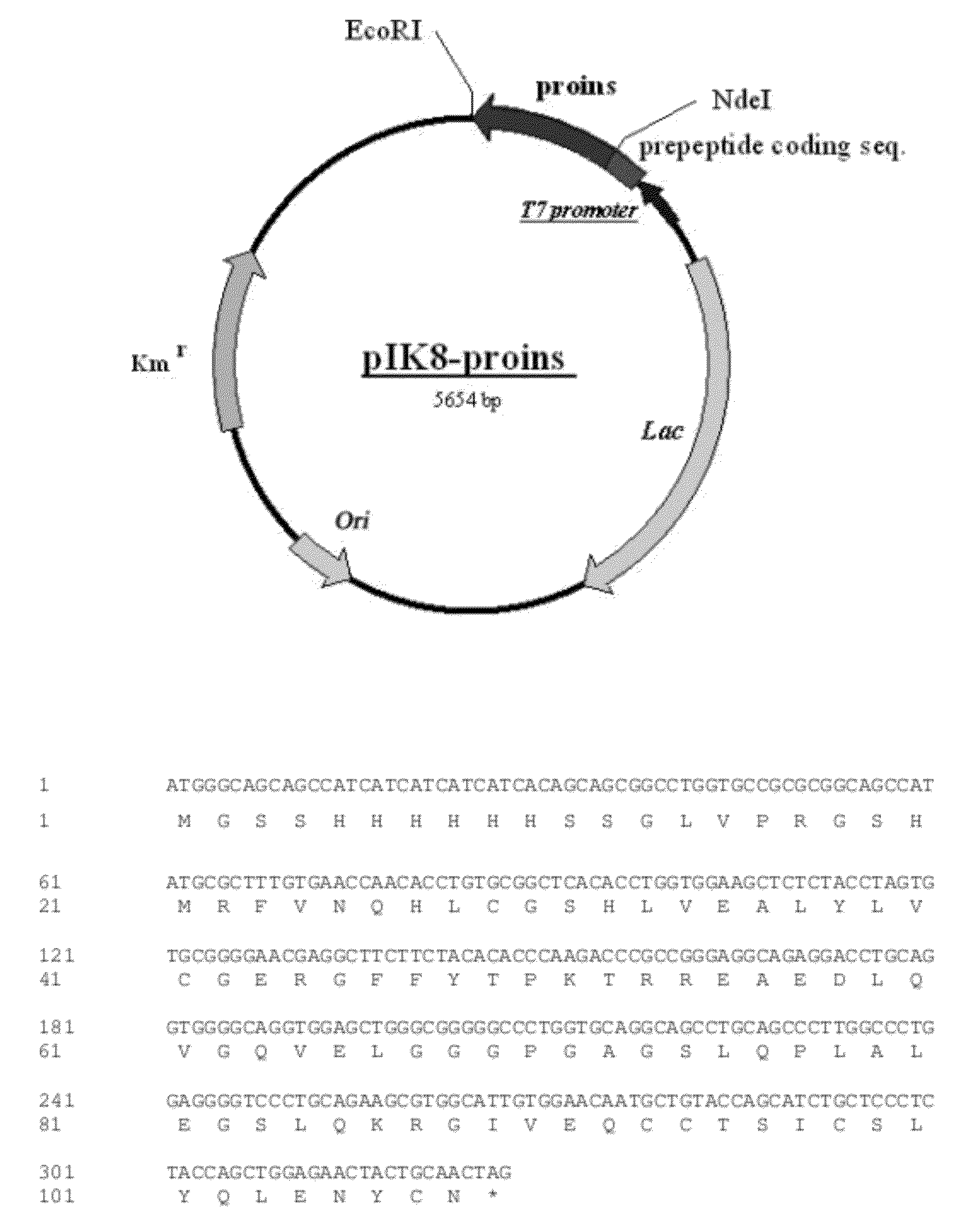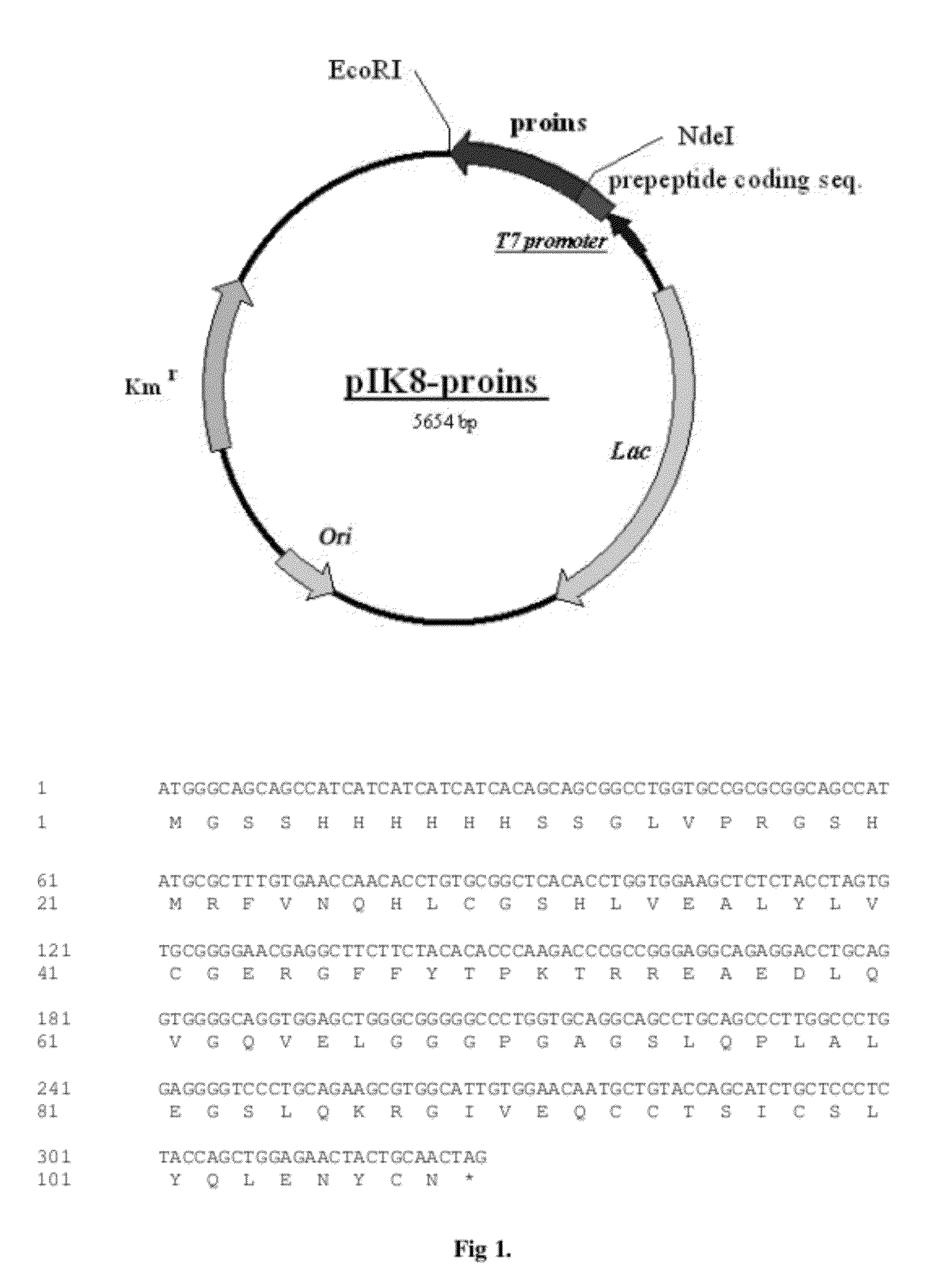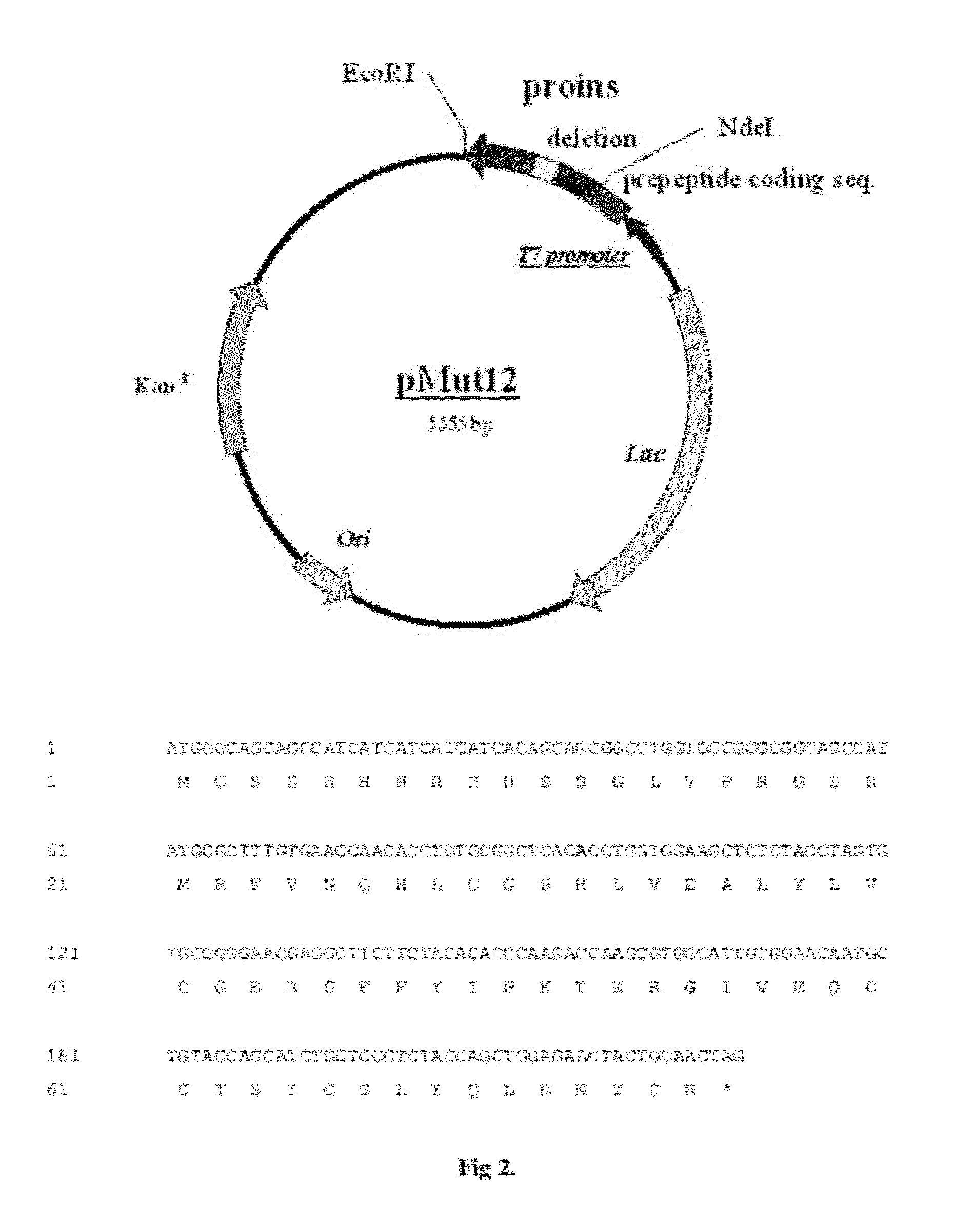Method for producing human recombinant insulin
a recombinant insulin and human technology, applied in the field of biotechnology, gene engineering and medicine, can solve the problems of limited human insulin production from porcine insulin, limited number of host/expression vector combinations, and high labor intensity and cost of purification of insulin during subsequent steps of insulin production, and achieves great quality and increased yield of hybrid polypeptides.
- Summary
- Abstract
- Description
- Claims
- Application Information
AI Technical Summary
Benefits of technology
Problems solved by technology
Method used
Image
Examples
example 1
Construction of Plasmid pIK8-proins
[0068]A human insulin cDNA was amplified from human pancreas single-stranded cDNA using the polymerase chain reaction (PCR) technique and primers P1 and P2:
primer P1 (forward primer)5′- GC CGATTTGTGAACCAACACCTGTG-3′primer P2 (reverse primer)5′- TG CTAGTTGCAGTAGTTCTCCAGC-3′
[0069]Primer P1 was designed to encode a fragment of human insulin B-chain starting with Arg22 of human preproinsulin and NdeI site (boxed) for cloning purposes. The reverse primer (P2) complements amino terminus of insulin A-chain and EcoRI site (boxed) for cloning purposes. The PCR reactions contained 25 pmoles of each oligo primer, 1×PCR buffer, 200 μM concentration of each of the four nucleotides (dA, dC, dG and dT), 2 ng of single-stranded cDNA, 5.0 units of Taq polymerase. The PCR reaction conditions were: 95° C. for 3 minutes, 35 cycles of (95° C. for 1 minute; 65° C. for 30 seconds; 72° C. for 30 seconds), followed by 5 minutes at 72° C. The approximate 280 bp PCR product ...
example 2
Construction of Plasmid pMUT12
[0071]Plasmid DNA pIK8-proins was used as a template in site directed mutagenesis using PCR and the following primers:
M1:5′- CTTCTACACACCCAAGACCAAGCGTGGCATTGTGGAACAATGCTG -3′M2:5′- CAGCATTGTTCCACAATGCCACGCTTGGTCTTGGGTGTGTAGAAG -3′
[0072]Following denaturation at 96° C. for 3 min 30 cycles of PCR were performed using 5 U rTth DNA polymerase. PCR conditions were as following: 94° C., 30 s; 59° C., 30 s; 72° C., 6 min and the final extension at 72° C. for 10 min PCR product was purified with Zymoclean PCR purification kit and digested with 10 U of DpnI—to remove an original template. After another round of column purification a 2mkl aliquot was transformed into Escherichia coli strain DH5alpha and transformants selected on LB plates containing kanamycin. Several colonies were grown overnight in LB media and plasmid DNA isolated using Wizard minipreps DNA isolation kit. Clone MUT12 was determined to have the correct DNA sequence. For expression in Escherichi...
example 3
Construction of Plasmid pISYN2
[0073]To construct pCSYN61 we first synthesized 5 oligodeoxynucleotides using the reported amino acid sequence of human insulin [10]. In these syntheses, we considered the codon usage in highly expressed genes of Escherichia coli [11] and Escherichia coli tRNA abundance [12]. We also included endonuclease recognition sites at various positions along our oligonucleotide sequences for cloning purpose.
Primer sequences:S1:5′- CATATGCGCTTTGTGAACCAG-3′S2:5′-AAGCCACGCTCGCCGCACACTAAATACAGCGCTTCCACCAGGTGGCTGCCACACAGATGCTGGTTCACAAAGCGCATATG-3′S3:5′-CGGCGAGCGTGGCTTCTTTTATACCCCGAAAACCAAACGTGGCATTGTGGAACAGTGTTGCACCAGTATTTGTAGCCTGT-3′S4:5′-CAGGCGTGAATTCTTAGTTGCAGTAATTTTCCAGCTGATACAGGCTACAAA TACTGGTGC-3′S5:5′- CAGGCGTGAATTCTTAGTTGC-3′
[0074]Mixture of primers S1, S2, S3, S4 (final concentration 2mkm each) in PCR buffer with 5 U of rTth polymerase were heated to 94° C. for 1 min, cooled to 62° C. and the reaction was carried out at 72° C. for 2 min to fill the gaps. Nex...
PUM
| Property | Measurement | Unit |
|---|---|---|
| concentrations | aaaaa | aaaaa |
| ionic strength | aaaaa | aaaaa |
| pH | aaaaa | aaaaa |
Abstract
Description
Claims
Application Information
 Login to View More
Login to View More - R&D
- Intellectual Property
- Life Sciences
- Materials
- Tech Scout
- Unparalleled Data Quality
- Higher Quality Content
- 60% Fewer Hallucinations
Browse by: Latest US Patents, China's latest patents, Technical Efficacy Thesaurus, Application Domain, Technology Topic, Popular Technical Reports.
© 2025 PatSnap. All rights reserved.Legal|Privacy policy|Modern Slavery Act Transparency Statement|Sitemap|About US| Contact US: help@patsnap.com



